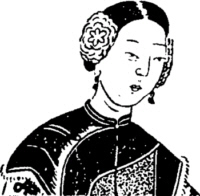Chapter 52 Section 5 Dressing
The hair style of Manchu women changes a lot, and it is almost the same as that of boys when they were children.Describing the ostentation of Jiamu's 80th birthday, "Mrs. Xing and Mrs. Wang led several daughters-in-law of Youshi Fengjie and several daughters-in-law, with two wild goose wings, standing behind Jiamu...there were 12 under the stage who did not leave their heads. The little girls are all dressed up as servants and serve them with their hands down" (Chapter 71).This little girl with no hair left is a girl dressed as a man.Girls grow their hair in a small bun in front of their foreheads, or wear a braid behind their heads when they grow up.Married women tend to have buns in buns, such as big buns reaching to the top of the head, curly buns (peng Peng) in front of the forehead, and braided buns. "Two heads" is a typical hairstyle of Manchu women.This hairstyle makes the neck straight and prevents it from twisting at will, so as to appear dignified and stable.Most of the people who wear this kind of bun are upper-class women.Generally, Manchu women often comb their wishful hair, that is, comb two flat buns on the left and right sides of the head, like wishful hair horizontally on the back of the head.Working women simply tie their hair up to the center of their heads in a bun.Later, influenced by the Chinese bun, some combed the bun into a flat shape, commonly known as "one character head".At the end of the Qing Dynasty, this kind of bun grew taller and taller, like an archway, and was named "Da La Chi".
Han women's hair bun jewelry, in the early Qing Dynasty, generally followed the style of the Ming Dynasty, and then gradually changed.In the middle of the Qing Dynasty, the hair style of the Manchu court ladies was imitated, and the high bun was the most popular.Divide the hair into two, commonly known as "fork head".Some have a lock of hair hanging behind their heads, trimmed into two sharp corners, which is called "swallowtail style".Later, styles such as round bun, flat bun, and wishful bun became popular.In addition, there are many fake buns, such as butterflies, arhats (upper buns and lower di), double flying swallows, eight-faced Guanyin and so on.At the end of the Qing Dynasty, there were styles such as Suzhou Jue, Babatou, Lianhuan bun, and twist.Young girls often wear clam-shaped hair, or the hair style is hollow like two wings, or only braids hang down the back of the head.Later, braiding gradually became popular and became the main hairstyle for young and middle-aged women.For headgear, northern women often use "Zhaojun set" in winter, which is made of mink fur to cover their foreheads.It is written that Grandma Liu saw "Sister Feng's family often wears (wears) a sable Zhaojun suit, and surrounds the Zanzhulezi" (Chapter Six).In the south of the Yangtze River, it is still fashionable to wear lezi, embellished with pearls and emeralds, or embroidered with flowers, and put them on the forehead to cover the ears.There are also hairpins on the topknot, which are made of gold, silver, jade, jade, etc., and some are made into a phoenix shape with hanging pearls and jade, just like the ancient steps.Others are made into various flower shapes, shaking slightly when walking, gorgeous and moving.

clam head

clam head
